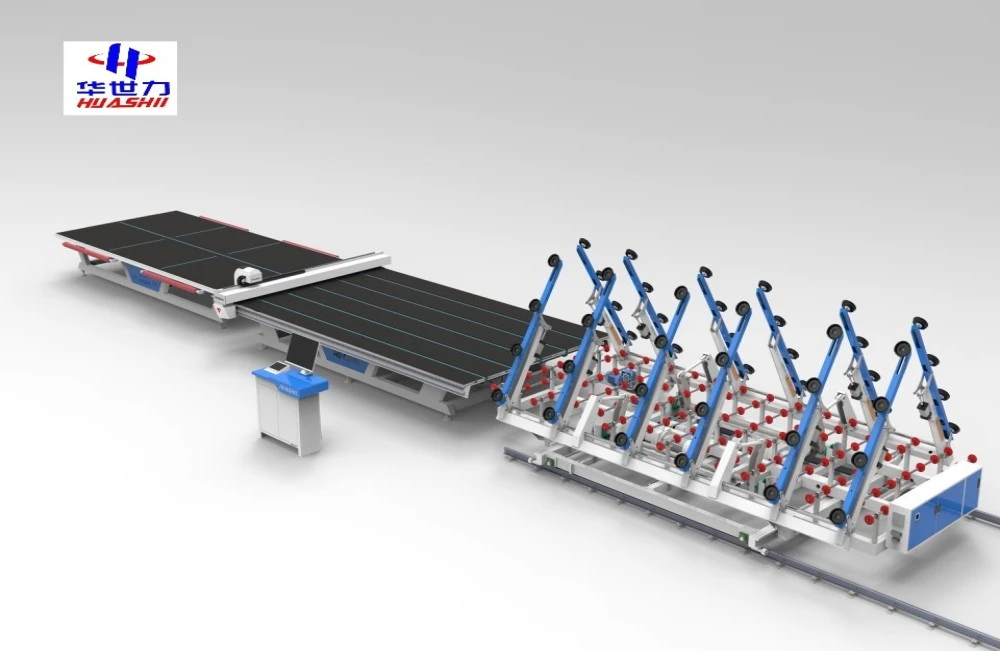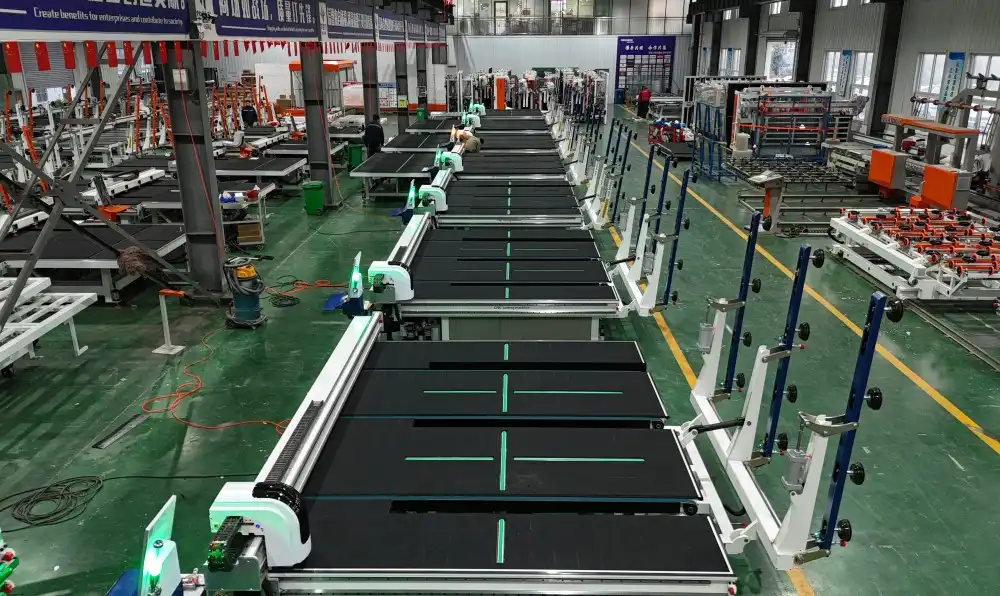In the world of glass manufacturing and processing, precision and efficiency are paramount. A high-quality cutting machine for glass plays a crucial role in achieving these goals. Whether you're in the architectural, automotive, or decorative glass industry, understanding the key components of these machines can help you make informed decisions and optimize your production process. Let's delve into the essential elements that make a cutting machine for glass stand out in terms of performance, reliability, and versatility.
Cutting heads: materials and design innovations
The cutting head is the heart of any cutting machine for glass. It's responsible for making precise incisions in the glass, and its design and materials significantly impact the quality of the cut. High-quality cutting machines for glass typically feature cutting heads made from durable materials such as tungsten carbide or diamond. These materials ensure longevity and maintain sharpness over extended periods of use.
Innovative designs in cutting heads have led to improved performance and versatility. Some cutting machines now incorporate oscillating cutting heads, which can make intricate cuts and shapes with ease. This feature is particularly useful for architectural glass applications where complex designs are often required.
Another advancement in cutting head technology for cutting machine for glass is the integration of automatic pressure adjustment systems. These systems can detect changes in glass thickness and adjust the cutting pressure accordingly, ensuring consistent cut quality across varying glass types and thicknesses. This adaptability is crucial for manufacturers working with a diverse range of glass products.
Cooling systems for cutting heads in cutting machine for glass have also seen significant improvements. Advanced cooling mechanisms help maintain optimal cutting temperatures, reducing the risk of thermal stress and improving overall cut quality. This is particularly important when working with thicker glass or during high-volume production runs.

Control systems: balancing automation and user input
The control system of a cutting machine for glass is the brain behind its operation. It coordinates all the machine's functions and plays a crucial role in determining the precision and efficiency of the cutting process. Modern control systems strike a balance between automation and user input, offering both ease of use and flexibility.
Cutting-edge control systems often feature intuitive touchscreen interfaces that allow operators to easily program cutting patterns, adjust parameters, and monitor the cutting process in real-time. These user-friendly interfaces reduce the learning curve for new operators and improve overall productivity.
Automation features in control systems have become increasingly sophisticated. Many high-quality cutting machines now offer automatic optimization of cutting patterns to minimize waste and maximize material utilization. This not only improves efficiency but also contributes to cost savings and sustainability efforts.
Integration capabilities are another crucial aspect of modern control systems. The ability to connect with other software systems, such as CAD/CAM programs or enterprise resource planning (ERP) systems, allows for seamless workflow integration. This connectivity enables manufacturers to streamline their production processes and improve overall operational efficiency.
Advanced control systems also incorporate diagnostic and maintenance features. These can include real-time monitoring of machine components, predictive maintenance alerts, and remote diagnostics capabilities. Such features help minimize downtime and ensure the longevity of the cutting machine for glass.
Supporting features for enhanced performance and efficiency
Beyond the cutting head and control system, several supporting features contribute to the overall performance and efficiency of a high-quality cutting machine for glass. These features work in tandem to ensure smooth operation, precise cutting, and optimal productivity.
One crucial supporting feature is the glass positioning system. High-quality cutting machines often incorporate advanced positioning mechanisms that ensure accurate alignment of the glass sheet before cutting begins. This may include automated loading systems, vacuum-assisted positioning, or laser alignment tools. Precise positioning is essential for achieving consistent cut quality and minimizing material waste.
The machine's frame and support structure also play a significant role in its performance. A robust, vibration-resistant frame ensures stability during the cutting process, which is crucial for maintaining precision, especially when making intricate cuts. Some advanced machines feature modular designs that allow for easy customization and future upgrades.
Dust and debris management systems are another important supporting feature of cutting machine for glass. Effective removal of glass particles during the cutting process not only improves cut quality but also contributes to a safer working environment and reduces maintenance requirements. High-quality cutting machine for glass often incorporate advanced filtration systems or even water-jet assisted cutting to manage debris effectively.
Energy efficiency features are becoming increasingly important in modern cutting machines for glass. These may include energy-recovery systems, intelligent power management, or the use of energy-efficient components. Such features not only reduce operating costs but also align with sustainability goals, which are becoming increasingly important in the manufacturing sector.
Safety features are, of course, paramount in any industrial machinery. High-quality cutting machine for glass incorporate various safety mechanisms such as emergency stop buttons, light curtains, and enclosed cutting areas. Advanced machines may also feature intelligent safety systems that can detect potential hazards and automatically adjust operation to prevent accidents.
The ability to handle different types of glass is another key feature of versatile cutting machines. Whether it's float glass, laminated glass, or specialized coated glass, a high-quality machine should be able to adapt its cutting parameters to suit different materials. This versatility is crucial for manufacturers who work with a diverse range of glass products.
Software integration capabilities extend beyond just the control system. High-quality cutting machine for glass often come with comprehensive software suites that offer features such as production planning, inventory management, and quality control. These integrated solutions help manufacturers optimize their entire production process, not just the cutting stage.
Maintenance and serviceability features are often overlooked but are crucial for long-term performance. High-quality cutting machine for glass are designed with easy access to key components, modular designs for quick part replacement, and comprehensive documentation to facilitate maintenance. Some advanced machines even incorporate self-diagnostic systems that can predict potential issues before they cause downtime.

Scalability is another important consideration, especially for growing businesses. Some cutting machines are designed with modular architectures that allow for easy upgrades or expansion of capabilities. This future-proofing can be a valuable feature, allowing manufacturers to adapt their equipment as their business needs evolve.
Finally, the quality of after-sales support and training provided by the manufacturer can significantly impact the long-term performance of the cutting machine. Look for manufacturers who offer comprehensive training programs, readily available technical support, and a robust spare parts supply chain.
Conclusion
A high-quality cutting machine for glass is a complex piece of equipment with numerous interrelated components and features. From the cutting head to the control system, and the various supporting features, each element plays a crucial role in determining the machine's overall performance, precision, and efficiency. By understanding these key components, glass manufacturers can make informed decisions when selecting or upgrading their cutting equipment, ultimately leading to improved productivity, reduced waste, and higher quality end products.
Are you looking to upgrade your glass cutting capabilities? At Shandong Huashil Automation Technology Co., LTD, we specialize in developing cutting-edge glass cutting machines that incorporate all the key components discussed in this article. Our years of experience in automated R&D, manufacturing, and sales of mechanical equipment allow us to offer solutions that meet the highest standards of precision, efficiency, and reliability. Whether you're in the architectural, automotive, or decorative glass industry, we have the expertise to help you optimize your production process. Don't let outdated equipment hold you back – contact us today at salescathy@sdhuashil.com to learn how our advanced glass cutting machines can transform your operations and give you a competitive edge in the market.
References
1. Johnson, M. (2022). "Advancements in Glass Cutting Technology: A Comprehensive Review." Journal of Glass Manufacturing, 45(3), 78-92.
2. Smith, A. & Brown, L. (2023). "The Impact of Automation on Glass Cutting Precision and Efficiency." International Journal of Industrial Automation, 18(2), 205-220.
3. Zhang, Y. et al. (2021). "Materials and Design Innovations in Glass Cutting Heads: A Comparative Study." Materials Science and Engineering: B, 263, 114836.
4. Thompson, R. (2023). "Energy Efficiency and Sustainability in Modern Glass Cutting Machines." Green Manufacturing Technologies, 7(4), 352-367.



